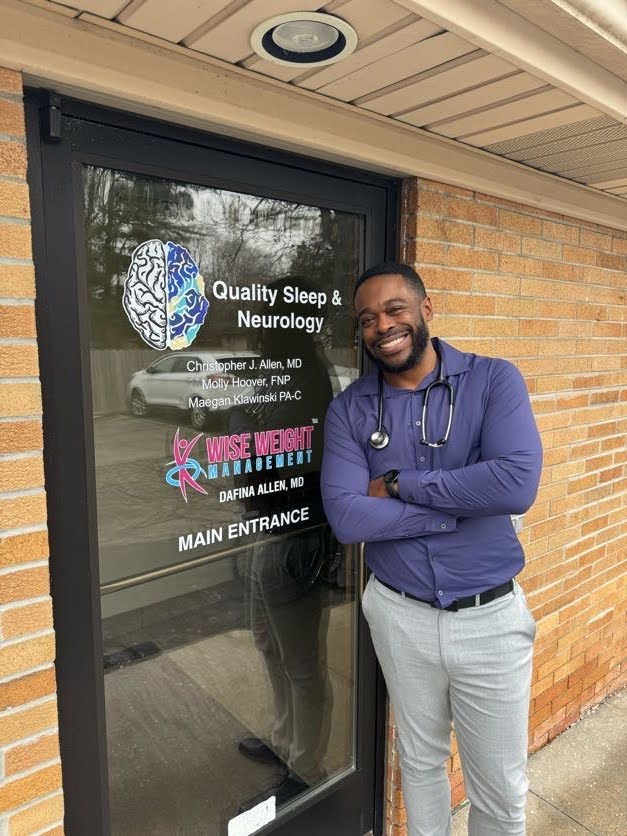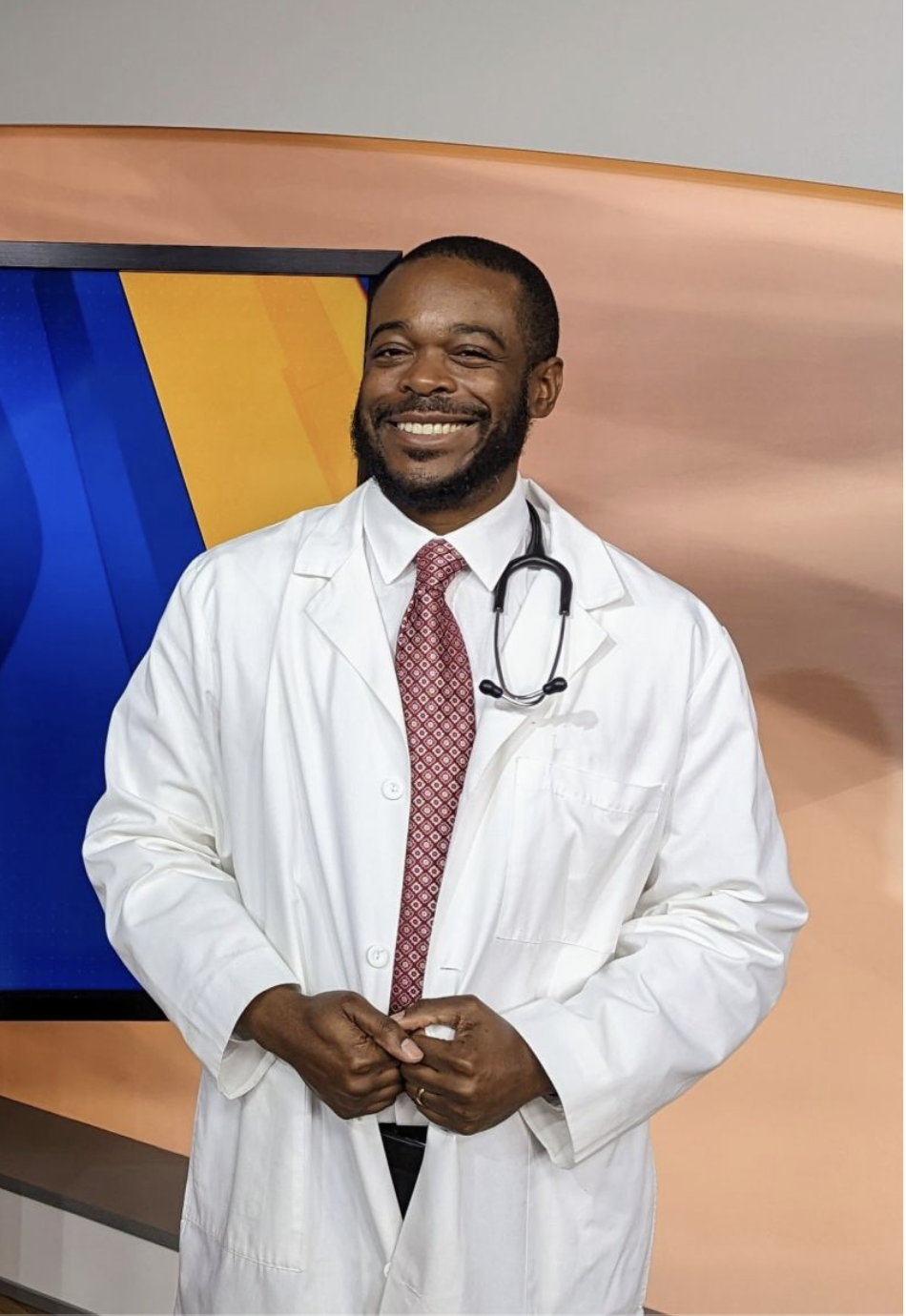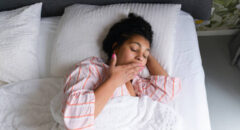
When Christopher J. Allen, MD, CEO, Pediatric Neurologist and Adult/Pediatric Sleep Medicine Doctor, was first diagnosed with sleep apnea over 20 years ago, he had no idea how it would change the trajectory of his life, both personally and professionally.
From Medical Student to Sleep Advocate
Today, the condition that left him chronically tired, mentally foggy, and emotionally drained is the foundation of his passion and purpose, but before that, his journey was riddled with delays and frustration.
“For years, I was that guy that would be tired. I was a person that no one wanted to share a room with because I was snoring. If it wasn’t for my class in med school that talked about sleep apnea, who knows if I would have ever been treated,” Dr. Chris tells BlackDoctor.org.
Dr. Chris’ delayed diagnosis is not an isolated incident.He emphasizes the importance of treatment and normalizing testing. “Sleep is not a luxury; it’s a necessity,” he states.
According to the American Medical Association, bout 30 million people in the United States have sleep apnea, but only six million are diagnosed with the condition.
“Unfortunately, there’s also been mistrust with the underserved community. Black people often normalize exhaustion because they’re used to grinding through life. Unfortunately, that mentality can delay diagnosis and treatment and lead to serious complications,” Dr. Chris says.
In his practice, he emphasizes the importance of treatment and normalizing testing. “Sleep is not a luxury, it’s a necessity,” he states.
This “aha” moment came when he went on a trip without his CPAP [continuous positive airway pressure therapy] and felt absolutely awful.
That experience provided him with a strong sense of empathy as a physician.
“I don’t just read the data, I relate to it. It makes me more empathetic towards my patients. That dual perspective helps me connect with my patients in a way that goes beyond the textbook,” he notes.
His experience without his CPAP machine also helped him understand how life-changing the treatment was, becoming the catalyst for his advocacy work around sleep health equity and access.
RELATED: Sleep Apnea: Hidden Warning Signs

How Understanding and Treatment Have Evolved
According to the Mayo Clinic, sleep apnea is a potentially serious sleep disorder in which breathing repeatedly stops and starts.
The main types of sleep apnea are:
- Obstructive sleep apnea (OSA), which is the more common form that occurs when throat muscles relax and block the flow of air into the lungs
- Central sleep apnea (CSA), which occurs when the brain doesn’t send proper signals to the muscles that control breathing
- Treatment-emergent central sleep apnea, also known as complex sleep apnea, which happens when someone has OSA — diagnosed with a sleep study — that converts to CSA when receiving therapy for OSA
The symptoms typically include:
- Loud snoring.
- Episodes in which you stop breathing during sleep — which would be reported by another person.
- Gasping for air during sleep.
- Awakening with a dry mouth.
- Morning headache.
- Difficulty staying asleep, known as insomnia.
- Excessive daytime sleepiness, known as hypersomnia.
- Difficulty paying attention while awake.
- Irritability.
The condition, which has typically been dismissed as a snoring problem or something that only affects older, overweight men, has come a long way.
“Now we know it affects all ages, body types, and ethnicities. It’s about having an airway compromised, where there is pausing or no breathing at all. It is also linked to serious health conditions like heart disease, stroke, diabetes, and even cognitive decline,” Dr. Chris explains.
Treatment options have also progressed over time.
“While CPAP is still the gold standard, we now have oral devices, positional therapy, and even surgical options. There’s even medication that can change the severity and ultimately treat obstructive sleep apnea,” Dr. Chris adds.
RELATED: 5 Overlooked Signs Of Sleep Apnea
Fighting Misconceptions, Especially in Underserved Communities
Despite the progress, there are still harmful myths that Dr. Chris encounters in his practice.
“One of the biggest myths is that sleep apnea only affects people who are visibly unhealthy or elderly. In reality, I see people from all walks of life with sleep apnea. In underserved communities, there’s also a cultural stigma around using machines or acknowledging fatigue as a medical issue,” Dr. Chris notes.
Sleep apnea also remains majorly underdiagnosed, especially in children and people of color.
To combat this, Dr. Chris advocates for improved education and trust within our communities and healthcare systems.
“We need to screen for sleep apnea more proactively in primary care settings, and we need public health campaigns that speak the language and reflect the values of the communities they serve,” he shares. “In children, we must advocate for better sleep evaluations. When children have sleep disorders, they are usually confused with other behavioral issues or attention difficulties, which are sometimes mistaken for ADHD.”
He also highlights the importance of representation in the medical field.
“When people of color see physicians who look like them talking openly about these issues, it makes a difference. I hold that mantle as an honor,” Dr. Chris says.
RELATED: Sleep Apnea 101: Everything You Need To Know For A Better Sleep
Meeting People Where They Are
Dr. Chris has witnessed the success of this mindset in his practice.
“I meet families where they are. I explain that if a child or adult is consistently struggling with sleep, snoring loudly, waking up gasping, or feeling tired all day, it’s not just ‘bad sleep’. There’s a strong chance it could be a sleep disorder,” Dr. Chris explains. “I emphasize the role of sleep in academic success, emotional regulation, and chronic disease prevention.”
As a dad, a husband, and someone who loves a good Netflix binge, Dr. Chris also believes in the importance of giving yourself grace.

Navigating a New Diagnosis
Dr. Chris knows the frustration of the long road to a sleep apnea diagnosis. Therefore, he prefers to focus on the positive aspects of this newfound diagnosis.
“You finally have answers. That diagnosis is not a defeat, it’s a doorway to feeling better than you have in years,” he says.
His advice?
Advocate for yourself throughout the journey, especially if something feels wrong or you are uncomfortable with the therapy.
“It took me three months to realize that it actually worked. Don’t expect perfection overnight. Get comfortable with your CPAP or device gradually, ask questions, and celebrate the wins,” he advises. “After a while, you’ll start to notice things, but it will probably be in hindsight. If there is trouble with CPAP therapy, remember that there are other ways to treat it. Remember, sleep apnea is a treatable condition, and getting it under control is one of the best gifts you can give to yourself and your loved ones.”
Looking ahead, Dr. Chris is focused on expanding sleep apnea access and awareness.
“I’m also partnering with organizations on health equity initiatives, and I recently joined Project Sleep to speak at public events and am on their advisory board. Looking ahead, I’m passionate about training the next generation of sleep specialists and advocating for better sleep health policies. As I always tell everyone, sleep is important,” he concludes.
Visit Dr. Chris’ sleep clinic, join a workshop, or follow @SleepDrChris for practical tips, support, and expert sleep advice.









